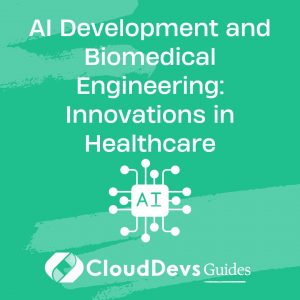AI Development and Biomedical Engineering: Innovations in Healthcare
Artificial intelligence (AI) is making significant strides in various industries, and biomedical engineering is no exception. The integration of AI with biomedical engineering is leading to groundbreaking innovations in healthcare, from advanced diagnostics to personalized medicine. This article delves into how AI is being utilized in biomedical engineering and provides practical examples of its impact on healthcare.
Understanding AI in Biomedical Engineering
Biomedical engineering combines the principles of engineering with biological sciences to develop technologies and devices that improve healthcare. When AI is integrated into this field, it enhances the ability to analyze complex biological data, develop predictive models, and create more effective healthcare solutions.
AI-Driven Innovations in Healthcare
AI has the potential to transform healthcare in several key areas, including diagnostics, treatment planning, drug discovery, and patient monitoring. Here, we explore how AI is being used in these areas with examples and insights.
-
Advanced Diagnostics with AI
One of the most promising applications of AI in healthcare is in diagnostics. AI algorithms can analyze medical images, genetic data, and patient records to detect diseases early and with greater accuracy.
Example: AI-Powered Diagnostic Imaging
Consider the use of AI in analyzing medical images such as X-rays, MRIs, and CT scans. AI models, particularly deep learning networks, can be trained to identify abnormalities and diseases like cancer with high precision.
```python
import tensorflow as tf
from tensorflow.keras import layers, models
Example of a simple CNN for image classification
model = models.Sequential([
layers.Conv2D(32, (3, 3), activation='relu', input_shape=(128, 128, 3)),
layers.MaxPooling2D((2, 2)),
layers.Conv2D(64, (3, 3), activation='relu'),
layers.MaxPooling2D((2, 2)),
layers.Conv2D(64, (3, 3), activation='relu'),
layers.Flatten(),
layers.Dense(64, activation='relu'),
layers.Dense(1, activation='sigmoid') Assuming binary classification
])
model.compile(optimizer='adam', loss='binary_crossentropy', metrics=['accuracy'])
The model would then be trained on labeled medical images
```
-
Personalized Treatment Planning
AI enables the development of personalized treatment plans based on individual patient data, including genetic information, lifestyle factors, and previous medical history.
Example: AI in Oncology for Personalized Cancer Treatment
AI algorithms can analyze genetic data to predict how a patient might respond to different cancer treatments, allowing for more tailored and effective treatment plans.
```python
import pandas as pd
from sklearn.ensemble import RandomForestClassifier
Example of a simple model to predict treatment response
data = pd.read_csv("patient_genetic_data.csv")
X = data.drop('TreatmentResponse', axis=1)
y = data['TreatmentResponse']
model = RandomForestClassifier()
model.fit(X, y)
The model could then be used to predict treatment responses for new patients
```
-
Drug Discovery and Development
AI accelerates the drug discovery process by predicting how different molecules will interact with biological targets, identifying potential drug candidates faster than traditional methods.
Example: AI in Drug Discovery
Machine learning models can predict the efficacy of new drug compounds by analyzing vast datasets of molecular structures and biological activity.
```python
from sklearn.model_selection import train_test_split
from sklearn.ensemble import GradientBoostingClassifier
Sample data loading and model training for drug discovery
X = pd.read_csv("compound_data.csv")
y = pd.read_csv("biological_activity.csv")
X_train, X_test, y_train, y_test = train_test_split(X, y, test_size=0.2)
model = GradientBoostingClassifier()
model.fit(X_train, y_train)
The model would then be used to predict the activity of new compounds
```
-
Patient Monitoring and Predictive Analytics
AI-powered devices and systems are increasingly used to monitor patients in real-time, enabling early detection of potential health issues and improving patient outcomes.
Example: AI in Wearable Devices for Health Monitoring
Wearable devices equipped with AI can continuously monitor vital signs and predict potential health crises, such as heart attacks, before they occur.
```python
import numpy as np
from sklearn.svm import SVC
Example of a simple AI model for predicting heart attacks
data = np.load("wearable_device_data.npy")
X = data['features']
y = data['labels']
model = SVC(kernel='linear')
model.fit(X, y)
The model could then be deployed in wearable devices to monitor patient health
```
Conclusion
AI is driving remarkable innovations in biomedical engineering, offering new possibilities for diagnostics, treatment, drug discovery, and patient care. As AI technologies continue to evolve, their integration with biomedical engineering will undoubtedly lead to even more significant advancements in healthcare, improving patient outcomes and saving lives.
Further Reading:
- [AI in Healthcare: Opportunities and Challenges](https://www.healthcareitnews.com/news/ai-healthcare-opportunities-and-challenges)
- [Biomedical Engineering and AI: A New Era of Healthcare Innovation](https://www.embs.org/ai-in-biomedical-engineering/)
- [AI-Driven Drug Discovery: The Future of Medicine](https://www.ncbi.nlm.nih.gov/pmc/articles/PMC7374795/)
Table of Contents









